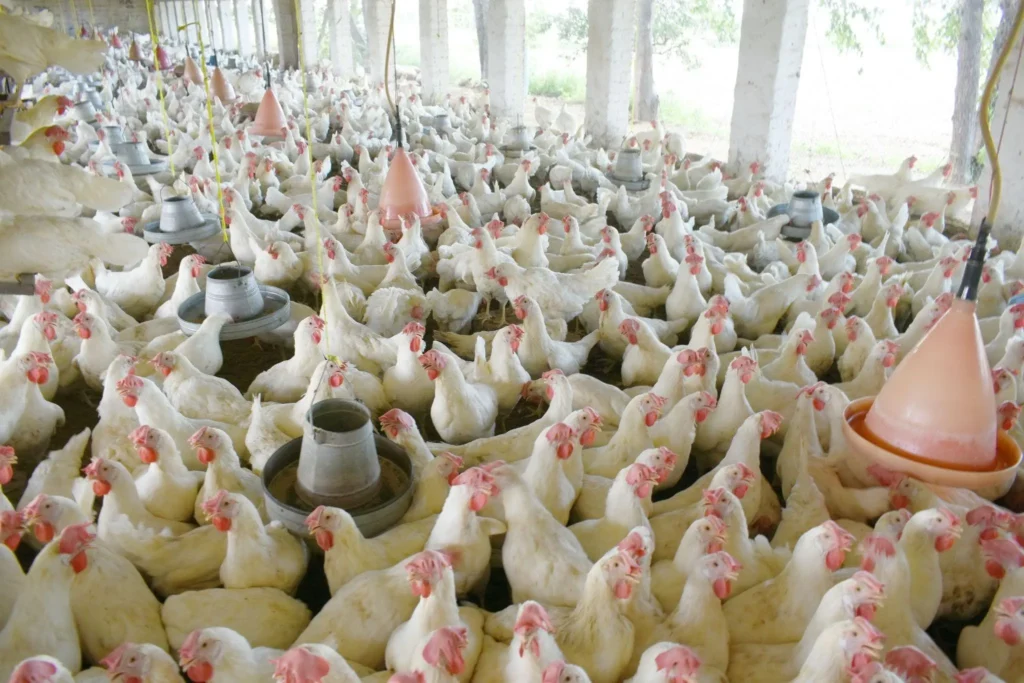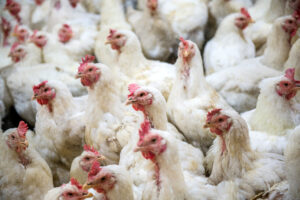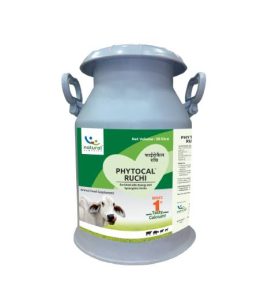Fatty liver syndrome in poultry is a common phenomenon that significantly leads to economic losses. Fatty liver in poultry is a lipid metabolism disorder (hepatic steatosis), which is a common cause of decreased egg production and even death among commercial laying hens or caged layer hens. Nearly 40% of the deaths among caged layers occur due to fatty liver hemorrhagic syndrome in poultry. The three most common diseases related to liver problems in poultry include Fatty Liver Haemorrhagic Syndrome (FLHS), Fatty Liver and Kidney Syndrome (FLKS) and Enlarged Liver.
The liver on the left is healthy, while the one on the right shows signs of fatty liver.
Excessive fat deposits characterize fatty liver hemorrhagic syndrome (FLHS) in poultry, affecting the liver and abdominal cavity and leading to hemorrhages. FLHS in poultry birds is similar to non-alcoholic fatty liver disease in humans. Since the liver is the first organ exposed to lipids, the liver in birds gets affected when fats are introduced into their body in adequate amounts. In mammals, fatty acid synthesis is absorbed in the adipose tissue first and then in the liver.
Lipogenesis in the liver is higher, especially in the female layers responsible for producing eggs. This is typical as the production of estrogen is high in layer hens to meet the demand of vitellogenesis, which leads to fatty liver syndrome in poultry. Generally, in worse scenarios, the hen dies while laying eggs.
Fatty Liver Syndrome In Poultry Symptoms
Fatty liver syndrome in poultry can affect birds of all age groups. Hens with this condition are often obese, carrying 20% or more excess weight, and show a sudden drop in egg production. Affected birds typically have pale combs, which may appear puffy. Their livers are usually enlarged, pale, soft, and filled with fat. This excess fat gives the liver a yellowish hue, making it soft and friable. The structural integrity of the liver is compromised, making it prone to rupture and haemorrhage. In severe cases, the liver can easily break apart when handled, and large blood clots may be found in the abdominal cavity, originating from a rupture in the liver capsule. In other cases, the liver appears greasy, and soft, with abundant fat deposits in the abdominal and intestinal (mesenteric) areas.
Additionally, fatty liver syndrome affects eggshell quality. The liver plays a crucial role in converting Vitamin D into its active form, which is essential for various metabolic processes. Hens affected by fatty liver hemorrhagic syndrome (FLHS) exhibit elevated serum calcium levels, indicating a disruption in the conversion of Vitamin D into its metabolically active form, 1,25(OH)₂D₃. This disruption directly impairs the eggshell formation process, compromising the overall quality of eggs.
Some of the other signs for fatty liver syndrome in poultry include:
- Reduced activity levels
- Dandruff on comb
- Excessive growth of the beak and toenails
- Dull feathers
- Increased intake of water
- Face and comb look yellow (jaundiced in appearance)
- Wet droppings or changes in manure are also observed.
Causes Of fatty liver syndrome in poultry
Fatty liver syndrome in poultry arises from multiple underlying causes, including nutritional, environmental, and hormonal factors, all of which can disrupt lipid utilisation in the liver. Some of the causes of fatty liver syndrome in poultry include:
1. Increased Feed Intake
Highly concentrated diets or excessive feed consumption increase body fats. Additionally, the food texture has an important role, which directly impacts the absorption process. Incorrect levels of amino acids or unbalanced protein can also lead to fatty liver syndrome in poultry.
Excessive carbohydrate (starch) consumption, especially as a replacement for fats, can contribute to the development of fatty liver syndrome in poultry. Corn-based diets may also play a role in fatty liver due to their lower choline content. Similarly, increased inclusion of wheat or maize in poultry diets can adversely affect the birds’ health, potentially leading to fatty liver syndrome. Since, caged birds are less active than the birds in the housing systems, feed should be balanced since they are at higher risk of receiving excess energy which leads to FLHS.
2. Estrogen Level
The hormone estrogen, linked to sexual maturity, stimulates the liver to store more fat for egg yolk synthesis. As the bird begins egg production, the liver size increases significantly in response to elevated estrogen levels. A combination of a positive energy balance and the effects of estrogen can make laying birds prone to developing fatty liver hemorrhagic syndrome in poultry. This highlights the importance of avoiding excessive energy intake, particularly during the early laying period when birds are at peak productivity.
3. Heat Stress
The incidence of fatty liver syndrome in poultry is highest during warm periods. Elevated environmental temperatures reduce energy requirements, leading to a more positive energy balance. To manage body temperature, birds rely on evaporative cooling through respiration. However, excess abdominal fat caused by surplus energy can disrupt normal breathing and cooling, making birds more vulnerable to heat stroke and liver rupture.
4. Mycotoxins
Mycotoxins, particularly aflatoxins commonly found in contaminated cereals, can lead to liver lipid accumulation and liver hemorrhages. Including rapeseed meal in the diet can increase the risk of fatty liver hemorrhagic syndrome in poultry, as erucic acid or other toxic metabolites may weaken liver connective tissue, resulting in hepatic cell damage and hemorrhaging.
5. Calcium Deficiency
Calcium deficiency is closely linked to fatty liver hemorrhagic syndrome in poultry. Inadequate calcium levels can disrupt lipid metabolism, leading to excessive fat accumulation in the liver. This imbalance weakens the liver’s structural integrity, increasing the risk of hemorrhages. Ensuring sufficient calcium intake is essential to reduce the likelihood of FLHS in poultry.
6. Other Factors
Several other factors associated with fatty liver in poultry include lack of biotin and choline in the feed, mouldy feed, toxin exposure, antioxidant deficiency, copper deficiency, thyroid dysfunction, and increased water consumption. Hereditary factors is also responsible for FLHS.
Treatment For Fatty Liver In Poultry
Once fatty liver syndrome in poultry is diagnosed, the most important point to focus is to check the feed. Poultry nutritionists should balance the feed with right amount of nutrients. Changing the balance of carbohydrates and fats with selenium is always suggested.
Additionally, affected birds should be separated from the flock and placed in a secure environment with sufficient feed. Observe their behaviour to ensure they are moving around properly. Provide adequate space and proper ventilation for their recovery. Offer nutritious foods like flax seeds, genistein, and milk thistle, as these polyherbal options help enhance energy levels in birds.
Prevention For Fatty Liver Syndrome In Poultry
Prevention is always better than cure. The key to managing and preventing fatty liver syndrome in poultry lies in a combination of nutritional and management strategies.
Here are some preventive measures to combat fatty liver syndrome in poultry:
- Maintain feed quality: Keep crude protein levels above 17.5% using a high-quality protein source. Ensure fat content remains below 3.5%.
- Avoid high sugar foods: Avoid excessive amounts of scratch or foods with high sugar content, such as grapes, which can contribute to fatty liver development.
- Provide supplements: Provide antioxidants and Vitamin B to support liver function and overall health.
- Control feed intake: Limit energetic over-consumption by adjusting feed intake and reducing the metabolizable energy (ME) of the feed.
- Modify feed composition: Decrease carbohydrate content by increasing fat rich in linoleic acid to make the diet less sensitive to fatty liver syndrome.
- Use lipotropes and vitamins: Incorporate lipotropes (such as lecithin, choline, inositol, betaine, and methionine) to support liver function and fat metabolism.
- Increase vitamin intake: Ensure an adequate supply of Vitamin B1, B12, folium acid, Biotine, and Vitamin E (in combination with selenium), which support metabolism and fat synthesis.
- Phytogenics for Liver Health: Phytogenics act as a natural analog to choline, supporting lipid metabolism and enhancing liver health in poultry, offering a sustainable and effective solution to prevent fatty liver syndrome.
By focusing on these strategies, it is possible to reduce the risk of fatty liver syndrome in poultry and promote a healthier, more productive poultry operation. Incorporating phytogenic feed supplements into poultry diets can further support liver health. These natural, plant-based solutions enhance metabolic function, reduce oxidative stress, and improve fat metabolism, making them a sustainable approach to managing fatty liver syndrome in poultry.
Kolin Plus, a greener alternative to choline chloride prevents flocks from fatty liver syndrome by supporting in fat mobilism, fat metabolization, and optimal muscle growth.
Read More:



















